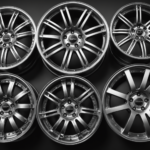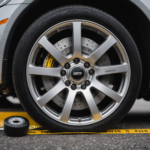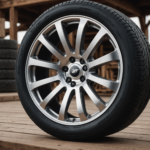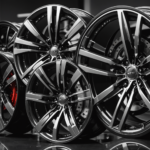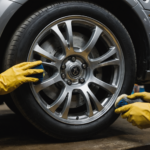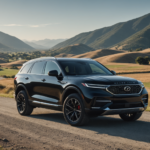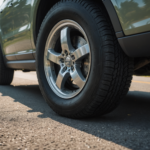In the world of off-roading, selecting the right wheels is just as crucial as choosing the perfect tires. The right wheels not only enhance performance and handling, but they also play a significant role in the aesthetics of an off-road vehicle. With numerous options available, understanding the different types of wheels, their materials, and fitment is essential for a successful off-roading experience. This comprehensive guide will delve into the intricacies of off-road wheels, offering insights and tips for making an informed decision.
Understanding Off-Road Wheels
Off-road wheels are specifically designed to endure the rigors of rugged terrains. They must not only support the weight of the vehicle but also provide a stable base for tires that are intended for adverse conditions. The primary functions of off-road wheels include:
- Weight Distribution
- Shock Absorption
- Enhanced Traction
- Durability against off-road obstacles
Types of Off-Road Wheels
Off-road wheels can be categorized into several types based on their design and intended use:
- Steel Wheels: Known for their durability and resistance to bends and cracks, steel wheels are often the go-to choice for many off-road enthusiasts.
- Aluminum Alloy Wheels: Lighter than steel wheels, aluminum alloy wheels can improve fuel efficiency and handling, making them a popular option for performance-oriented off-roaders.
- Beadlock Wheels: Designed specifically for extreme off-roading, beadlock wheels allow the tire to be locked onto the wheel, preventing it from slipping off during challenging maneuvers.
Materials and Construction
The material and construction of off-road wheels are critical factors that determine their performance and longevity. Here’s a closer look at common materials used:
Steel
Steel wheels are highly favored for their strength. They are less likely to deform upon impact with rocks or other obstacles. However, they are heavier than aluminum wheels, which can impact the overall vehicle performance. Steel wheels are generally less expensive but can be prone to rust if not properly maintained.
Aluminum Alloys
Aluminum alloy wheels typically offer a better weight-to-strength ratio compared to steel. They can improve a vehicle’s acceleration and fuel efficiency. Furthermore, these wheels come in various finishes and designs, providing aesthetic value. However, they can be more vulnerable to damage from impacts or rough conditions if not constructed using high-quality materials.
Forged vs. Cast Wheels
Off-road wheels can also be classified into two subcategories based on their manufacturing process:
- Forged Wheels: Manufactured from a solid piece of aluminum, forged wheels are made through a high-pressure process that aligns the grain structure, resulting in enhanced strength and performance.
- Cast Wheels: Created by pouring aluminum into a mold, cast wheels are generally more affordable but tend to be less durable than forged wheels.
Wheel Size and Fitment
Choosing the correct wheel size is essential for optimizing performance. Off-road wheels come in various diameters, widths, and offsets. Factors such as the vehicle type and tire size must be considered when selecting the appropriate wheel size.
Diameter
The diameter of the wheel influences the overall performance of the vehicle. Common diameters for off-road wheels range from 15 inches to 20 inches. Increasing the diameter can provide better ground clearance but may require modification to the wheel wells.
Width
Wheel width affects tire stability. Wider wheels can improve traction on loose terrains but may also increase rolling resistance. It’s crucial to balance width with the intended use of the vehicle.
Offset and Backspacing
Offset is the distance from the wheel’s centerline to its mounting surface. Proper offset is vital to maintaining vehicle handling and stability. There are three types of offsets: positive, negative, and zero. Here’s a quick overview:
| Offset Type | Description |
|---|---|
| Positive Offset | The mounting surface is closer to the outside of the wheel. Ideal for vehicles that require a wider stance and better handling. |
| Negative Offset | The mounting surface is closer to the inside of the wheel. This offset allows for wider tires but requires careful consideration to avoid rubbing on suspension parts. |
| Zero Offset | The mounting surface is aligned with the centerline of the wheel, offering a balance between stability and clearance. |
Factors to Consider When Choosing Off-Road Wheels
Several critical factors should guide the decision-making process when selecting off-road wheels:
Terrain Type
The type of terrain the vehicle will be traversing plays a significant role in selecting the right wheels. For rocky or rugged terrains, sturdy steel wheels may be preferable. In contrast, sandy or muddy conditions may benefit from lighter aluminum alloy wheels that enhance maneuverability.
Vehicle Weight and Load Capacity
Understanding the weight of the vehicle and its load capacity is vital. Overloading wheels can cause failures, leading to safety hazards and additional costs for repairs. Always refer to manufacturer specifications for weight limits.
Desired Aesthetics
Aesthetics may not be the primary focus for all off-roaders, but they are nonetheless important. Off-road wheels come in a variety of styles, finishes, and colors. Choosing a design that complements the vehicle’s characteristics can enhance its overall appeal.
Maintenance and Care of Off-Road Wheels
Regular maintenance is crucial to prolonging the lifespan of off-road wheels. Here are some maintenance tips:
- Regular Cleaning: Dirt, mud, and grime can build up on wheels, leading to corrosion and damage. Regular washing can mitigate these risks.
- Visual Inspections: Periodically inspect wheels for dents, cracks, or any visible damage that may compromise performance.
- Check for Rust: Steel wheels are particularly susceptible to rust. If rust is observed, consider using a rust inhibitor or re-coating.
Conclusion
Choosing the right wheels for off-roading applications is a multifaceted process that requires careful consideration of various factors like material, size, and intended use. Understanding the different types of wheels and their features ensures off-road enthusiasts make informed decisions that enhance their driving experience. Proper maintenance can further enhance performance, making the investment in quality off-road wheels worthwhile. Whether traversing rocky paths or muddy trails, selecting the best off-road wheels can significantly impact the performance and style of any vehicle.
This HTML-formatted article is structured with various headings and subheadings, lists, and a table, all designed to keep readers engaged while providing comprehensive information on the topic.




